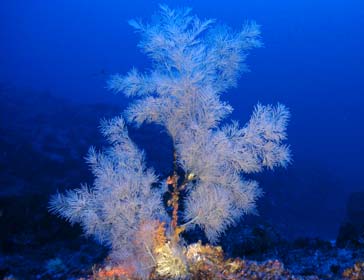Learn more: Deep-sea Corals and Sponges
 Deep-sea corals and sponges, some of the oldest animals on Earth, grow at the rate of just a few millimeters each year and can live for thousands of years. In recent years, scientists worldwide have discovered that the majority of the coral species found in the world’s oceans live in deep or cold waters.
Deep-sea corals and sponges, some of the oldest animals on Earth, grow at the rate of just a few millimeters each year and can live for thousands of years. In recent years, scientists worldwide have discovered that the majority of the coral species found in the world’s oceans live in deep or cold waters.
Deep-sea corals are typically found along continental margins, seamounts, undersea canyons and ridges. Some individual corals grow together to form small bushes or fans; others form larger colonies such as reefs or great trees. Two-thirds of all coral species are deep-sea corals.
Deep-sea corals and sponges are essential to the ocean’s health because they preserve ocean biodiversity and long-term sustainability of commercial and recreational fish species. Deep-sea corals can form reefs and gardens that are essential to numerous oceanic species — including fish — by providing shelter, protection from strong currents and predators, nurseries for young fish and feeding, spawning, resting and breeding areas for a host of other marine life.
Deep-sea coral habitats are subject to growing human impacts, particularly from deep-sea trawl fisheries in deep water regions. Even a single pass of a bottom trawl can flatten centuries of growth.
Destructive bottom trawls and dredges are especially threatening to deep-sea coral communities found in deep ocean canyons and areas that lie along the continental shelf. Fishing in those places with bottom trawling gear can rapidly destroy broad expanses of deep-sea coral and sponge gardens that take centuries to regrow and may never fully recover.

